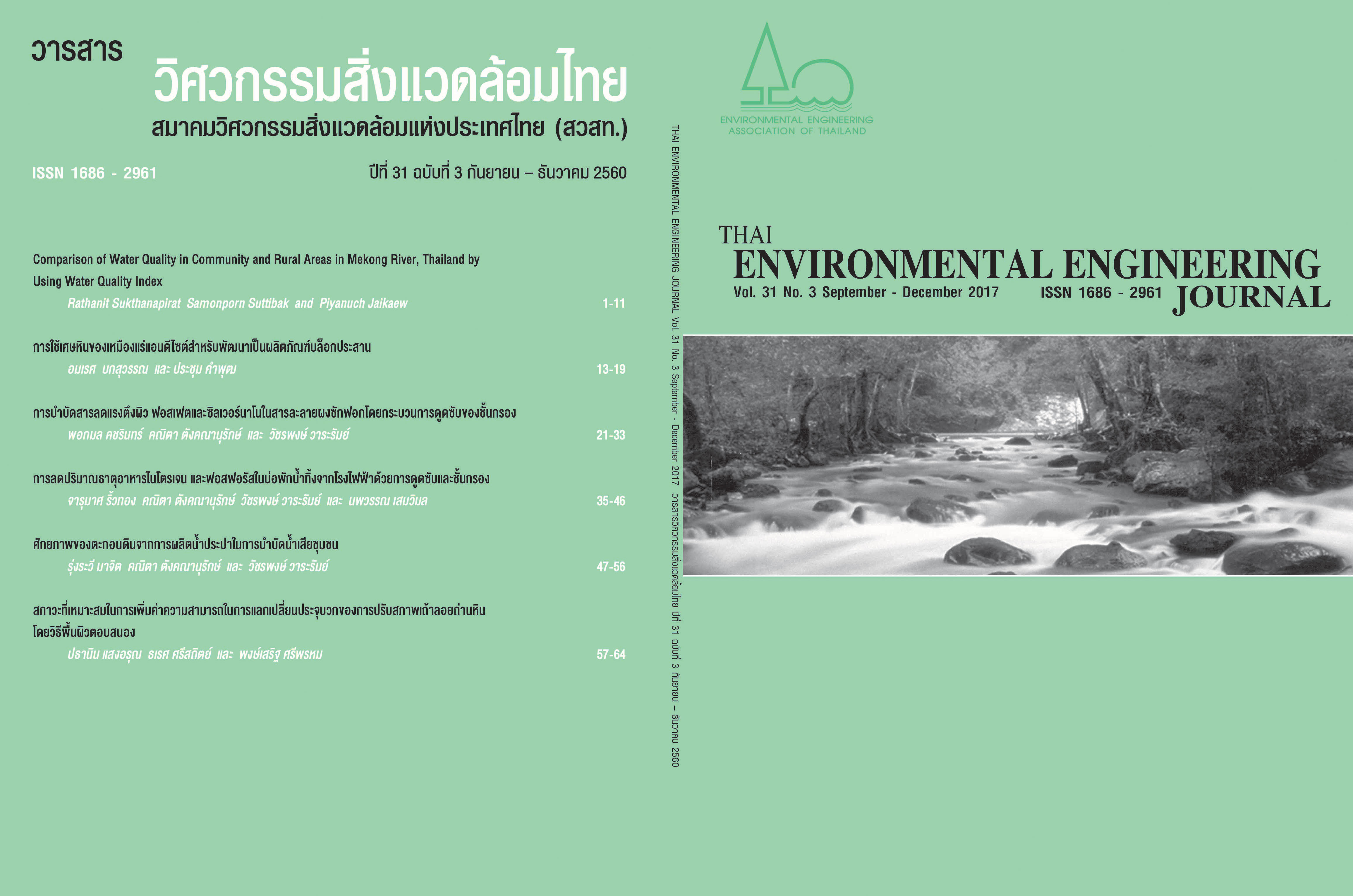Optimization of High Cation Exchange Capacity Modified Coal Fly Ash Using Response Surface Methodology
Main Article Content
Abstract
The optimization of high Cation Exchange Capacity (CEC) of the modified coal fly ash was studied. CEC of the coal fly ash before modification was 61.28 meq/100 g. The experimental condition was designed by Box- Benkhen design. The independent variables are retention time (12-36 hr), NaOH concentration (2-4 M) and temperature (80-100 Cº). The result showed that the independent variables had no significant effect to CEC at 95% confidence level (P>0.05). However, The interaction effect between retention time with temperature and NaOH concentration with temperature have significant effect to CEC at 95% confidence level (P<0.05) Thus, the optimum condition of high CEC (272.12 meq/100 g) was 34 hr of retention time, 4M of NaOH concentration and 80 Cº of temperature. The optimum condition was validated by experimental with 3 times. The results found that CEC of the validated optimum was 269.50±2 meq/100 g which was closely the predicted value.
Article Details
References
[2] Kondru, A.K., Kumar, P., Teng, T.T., Chand, S. and Wasewar, KL. 2011. Synthesis and characterization of Na-Y zeolite from coal fly ash and its effectiveness in removal of dye from aqueous solution by wet peroxide oxidation. Arch Environ Sci. 5: 46-54.
[3] Chen, J.G., Kong, H.N., Wu, D.Y., Hu, Z.B., Wang, Z.S. and Wang, Y.H. 2006. Removal of phosphate from aqueous solution by zeolite synthesized from fly ash, Journal of Colloid and Interface Science. 300: 491-497.
[4] Al-Shawabkeh, A., Matsuda, H., Hasatani, M. 1995. Comparative reactivity of treated FBC- and PCC-fly ash for SO2 removal. Can J. Chem. Eng. 73: 678-85.
[5] Zhang, M., Zhang, H., Xu, D., Han, L., Niu, D., Tian, B., Zhang, J., Zhang, L. and Wu, W. 2011. Removal of ammonium from aqueous solutions using zeolite synthesized from fly ash by a fusion method Desalination. 271: 111-121.
[6] Song, C., Y. Kitamura, and S. Li. 2014. Optimization of a novel cryogenic CO2 capture process by response surface methodology (RSM). J. Taiwan Inst. Chem. Eng. 45: 1666-1676.
[7] Ray, S., Reaume, S.J. and Lalman, J.A. 2010. Developing a statistical model to predict hydrogen production by a mixed anaerobic mesophilic culture. International Journal of Hydrogen Energy 35: 5332-5342.
[8] Tantriratna, P., Wirojanagud, W., Neramittagapong, S., Wantala, K. and Grisdanurak, N. 2011. Optimization for UV-photocatalytic degradation of paraquat over titanium dioxide supported on rice husk silica using Box-Behnken design, Indian J. Chem. Technol. 18: 363-371.
[9] Wantala, K., Khongkasem, E., Khlongkarnpanich, N., Sthiannopkao, S. and Kim, K.-W. 2012. Optimization of As(V) adsorption on Fe-RH-MCM-41-immobilized GAC using Box–Behnken Design: Effects of pH, loadings, and initial concentrations, Appl. Geochem. 27: 1027-1034.
[10] Wang, Y. and Lin, F. 2009. Synthesis of high capacity cation exchangers from a low-grade Chinese natural Zeolite. J. Hazard Mater. 166: 1014-1019.
[11] Breck, D.W. 1974. Zeolite Molecular Sieves, John Wiley and Sons, New York.
[12] Ojha, K., Pradhan, N.C. and Samanta, A.N. 2004. Zeolite from fly ash: synthesis and characterization, Bull. Mater. Sci. 27: 555-564.
[13] Shigemoto, N., Hayashi, H. and Miyaura, K. 1993. Selective formation of Na-X zeolite from coal fly ash by fusion with sodium hydroxide prior to hydrothermal reaction, J. Mater. Sci. 28: 4781-4786.


